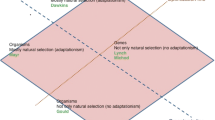Abstract
I argue that Grafen’s formal darwinism project could profitably incorporate a gene’s-eye view, as informed by the major transitions framework. In this, instead of the individual being assumed to maximise its inclusive fitness, genes are assumed to maximise their inclusive fitness. Maximisation of fitness at the individual level is not a straightforward concept because the major transitions framework shows that there are several kinds of biological individual. In addition, individuals have a definable fitness, exhibit individual-level adaptations and arise in a major transition, only to the extent that the inclusive-fitness interests of genes within them coincide. Therefore, as others have suggested, the fundamental level at which fitness is maximised is the gene level. Previous reconciliations of the concepts of gene-level fitness and individual-level fitness implicitly recognise this point. Adaptations always maximise the fitness of their causative genes, but may be simple or complex. Simple adaptations may be controlled by single genes and be maladaptive at higher levels, whereas complex adaptations are controlled by multiple genes and rely on those genes having coinciding fitness interests at a higher level, for a given trait.
Similar content being viewed by others
References
Beekman M, Ratnieks FLW (2003) Power over reproduction in social Hymenoptera. Philos Trans R Soc Lond B 358:1741–1753
Boomsma JJ (2009) Lifetime monogamy and the evolution of eusociality. Philos Trans R Soc B 364:3191–3207
Bourke AFG (2011) Principles of social evolution. Oxford University Press, Oxford
Bourke AFG, Franks NR (1995) Social evolution in ants. Princeton University Press, Princeton
Burt A, Trivers R (2006) Genes in conflict: the biology of selfish genetic elements. The Belknap Press of Harvard University Press, Cambridge, MA
Buss LW (1987) The evolution of individuality. Princeton University Press, Princeton
Calcott B, Sterelny K (eds) (2011) The major transitions in evolution revisited. The MIT Press, Cambridge, MA
Cosmides LM, Tooby J (1981) Cytoplasmic inheritance and intragenomic conflict. J Theor Biol 89:83–129
Dawkins R (1976) The selfish gene. Oxford University Press, Oxford
Dawkins R (1982) The extended phenotype. W. H. Freeman, Oxford
Gardner A (2009) Adaptation as organism design. Biol Lett 5:861–864
Gardner A, Grafen A (2009) Capturing the superorganism: a formal theory of group adaptation. J Evol Biol 22:659–671
Gardner A, Welch JJ (2011) A formal theory of the selfish gene. J Evol Biol 24:1801–1813
Grafen A (2006) Optimization of inclusive fitness. J Theor Biol 238:541–563
Grafen A (2014) The formal darwinism project in outline. Biol Philos 29(2). doi:10.1007/s10539-013-9414-y
Haig D (1997) The social gene. In: Krebs JR, Davies NB (eds) Behavioural ecology: an evolutionary approach, 4th edn. Blackwell Science Ltd, Oxford, pp 284–304
Haig D (2012) The strategic gene. Biol Philos 27:461–479
Hamilton WD (1963) The evolution of altruistic behavior. Am Nat 97:354–356
Leigh EG (1977) How does selection reconcile individual advantage with the good of the group? Proc Natl Acad Sci USA 74:4542–4546
Maynard Smith J, Szathmáry E (1995) The major transitions in evolution. W. H. Freeman, Oxford
Michod RE (2000) Darwinian dynamics: evolutionary transitions in fitness and individuality. Princeton University Press, Princeton
Michod RE (2005) On the transfer of fitness from the cell to the multicellular organism. Biol Philos 20:967–987
Okasha S (2006) Evolution and the levels of selection. Clarendon Press, Oxford
Okasha S, Paternotte C (2012) Group adaptation, formal darwinism and contextual analysis. J Evol Biol 25:1127–1139
Queller DC (2000) Relatedness and the fraternal major transitions. Philos Trans R Soc Lond B 355:1647–1655
Queller DC, Strassmann JE (2009) Beyond society: the evolution of organismality. Philos Trans R Soc B 364:3143–3155
Ratnieks FLW (1988) Reproductive harmony via mutual policing by workers in eusocial Hymenoptera. Am Nat 132:217–236
Ratnieks FLW, Reeve HK (1992) Conflict in single-queen Hymenopteran societies: the structure of conflict and processes that reduce conflict in advanced eusocial species. J Theor Biol 158:33–65
Ratnieks FLW, Foster KR, Wenseleers T (2006) Conflict resolution in insect societies. Annu Rev Entomol 51:581–608
Seeley TD (1997) Honey bee colonies are group-level adaptive units. Am Nat 150:S22–S41
Trivers RL, Hare H (1976) Haplodiploidy and the evolution of the social insects. Science 191:249–263
West SA, Kiers ET (2009) Evolution: what is an organism? Curr Biol 19:R1080–R1082
Williams GC (1966) Adaptation and natural selection. Princeton University Press, Princeton
Williams GC (1992) Natural selection: domains, levels, and challenges. Oxford University Press, New York
Woyciechowski M, Kuszewska K (2012) Swarming generates rebel workers in honeybees. Curr Biol 22:707–711
Author information
Authors and Affiliations
Corresponding author
Rights and permissions
About this article
Cite this article
Bourke, A.F.G. The gene’s-eye view, major transitions and the formal darwinism project. Biol Philos 29, 241–248 (2014). https://doi.org/10.1007/s10539-013-9422-y
Accepted:
Published:
Issue Date:
DOI: https://doi.org/10.1007/s10539-013-9422-y




